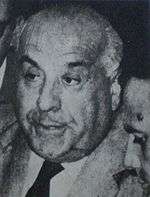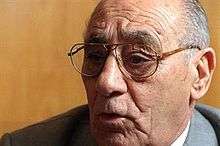Lebanese Argentines
Notable Lebanese Argentines: Juan Luis Manzur · Felipe Sapag Julio Asad · Mohamed Alí Seineldín Carlos Balá · Elías Sapag Alfredo Avelín · Antonio Alegre Jorge Sapag · Antonio Alegre Omar Asad | ||||||||||
| Total population | ||||||||||
|---|---|---|---|---|---|---|---|---|---|---|
| (1,500,000[1]) | ||||||||||
| Regions with significant populations | ||||||||||
| Throughout Argentina | ||||||||||
| Languages | ||||||||||
| Rioplatense Spanish, Arabic (Lebanese Arabic) | ||||||||||
| Religion | ||||||||||
|
Maronite Catholic, Eastern Orthodox, Melkite, with Shia Islam, Sunni Islam and Judaism minorities | ||||||||||
| Related ethnic groups | ||||||||||
| Lebanese people, Arab Argentines, Lebanese Americans, Lebanese Brazilians, Lebanese Canadians, Lebanese Australians, Argentine Jews, Spanish Argentines, Lebanese Spaniards | ||||||||||
Lebanese Argentines refers to Argentine citizens of Lebanese descent or Lebanon-born people who resides in Argentina. Many of the Lebanese Argentines are descendants of immigrants, largely of Arab cultural and linguistic heritage and/or identity, originating from what is now Lebanon.
Although a highly diverse group of Argentines — in ancestral origins, religion and historic identities — Lebanese Argentines hold a heritage that shares common linguistic, cultural, and political traditions.
The majority of the 1,500,000 million Lebanese Argentines are Christians, with Muslims and Jews being a small minority in comparison to them. The interethnic marriage in the Lebanese community, regardless of religious affiliation, is very high; most community members have only one parent who has Arab ethnicity. As a result of this, the Lebanese community in Argentina shows marked language shift away from Arabic. Only a few speak any Arabic, and such knowledge is often limited to a few basic words. Instead the majority, especially those of younger generations, speak Spanish as a first language.
History
In the 19th century, the first Lebanese settled in Argentina. From 1891 to 1920, 367,348 people of Arabic heritage immigrated into Argentina. When they were first processed in the ports of Argentina, they were classified as Turks because what is modern day Lebanon was a territory of the Turkish Ottoman Empire.[2] The causes for Lebanese to leave their homeland were an accelerated increase in demographics in Lebanon, the persecution by the Ottoman Turks, and the Italo-Turkish War. The Lebanese immigrants settle in the provinces of Buenos Aires, Cordoba, Salta, Tucumán, La Rioja, San Juan, Mendoza, Santiago del Estero, Misiones, Chaco, and the Patagonia. A large percentage of Lebanese settled in the Cuyo region (which is made up of the provinces of San Juan, San Luis, Mendoza, and La Rioja)
Some prominent ancestral places of origin of Lebanese Argentinians include: Aley, Amioun, Amsheet, Baalbek, Batroun, Beirut, Iaal, Jounieh, Mish Mish, Toula, Tripoli, Zahlé, Zgharta.
See also
- List of Lebanese people in Argentina
- Argentines
- Immigration to Argentina
- Lebanese diaspora
- Lebanese Americans
- Lebanese Canadians
- Lebanese Australians
- Lebanese Brazilians
- Lebanese British
- Lebanese people in Ecuador
- Arab Argentines
- Arab Mexicans
- Islam in Argentina
- Latin American Muslims
- Islamic Organization of Latin America
References
- ↑ Argentinian President's visit to the Lebanese Parliament. the Lebanese Parliament. lp.gov.lb
- ↑ Recopilaron casi 200 años de los sirio libaneses en Argentina
| ||||||||||||||||||||||||||||||||||||||||||||||
| ||||||||||||||||||||||||
| ||||||||||||||||||||||||||||||||||||||||||||||||||||||||




.jpg)
_1.jpg)


